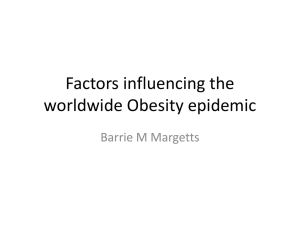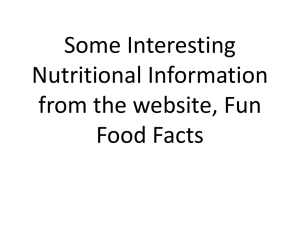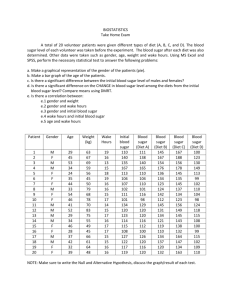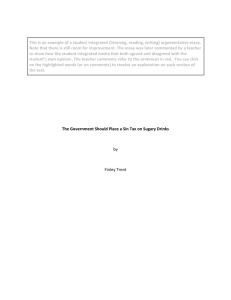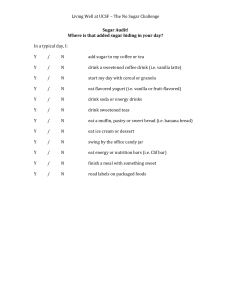Dairy - Utah State University Extension
advertisement
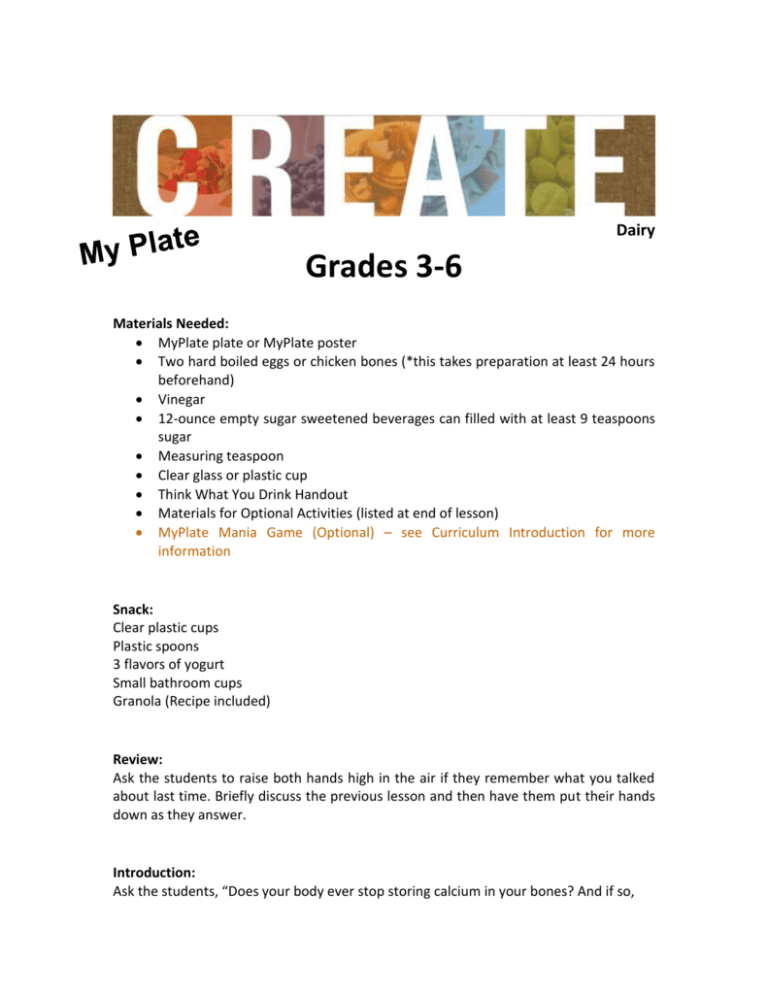
Dairy Grades 3-6 Materials Needed: MyPlate plate or MyPlate poster Two hard boiled eggs or chicken bones (*this takes preparation at least 24 hours beforehand) Vinegar 12-ounce empty sugar sweetened beverages can filled with at least 9 teaspoons sugar Measuring teaspoon Clear glass or plastic cup Think What You Drink Handout Materials for Optional Activities (listed at end of lesson) MyPlate Mania Game (Optional) – see Curriculum Introduction for more information Snack: Clear plastic cups Plastic spoons 3 flavors of yogurt Small bathroom cups Granola (Recipe included) Review: Ask the students to raise both hands high in the air if they remember what you talked about last time. Briefly discuss the previous lesson and then have them put their hands down as they answer. Introduction: Ask the students, “Does your body ever stop storing calcium in your bones? And if so, when?” (When you stop growing taller). Your body requires a certain amount of calcium to function every single day. If you don't get enough from the food you eat, where do you get it? That's right—your body will take it from your bones. When you are still growing, your body stores the calcium but what happens when you are my age and your body stops storing it in your bones? (Then it takes it from your body and causes little holes which is called osteoporosis) Why would that be a bad thing? (Bones become weak and break easily and sometimes can't support your weight.) You need to get enough calcium when you are your age so your body can use and store what it needs. You need to get enough calcium now, so when you are older your body doesn't take it from your bones. Objective: The students will see what happens when they do not get enough calcium. (Adapted from Professor Popcorn, Purdue University) Option 1: Chicken Bone Experiment (Note: Start this at least three days in advance [six is better].) Place a chicken leg bone in each bowl or cup. Add water to one bowl and vinegar to the other. Cover each bone with the liquid. Let the bones sit in the solution for three days or longer. During this lesson: Pass the chicken bone that was soaked in water around the class so the youth can feel its rigidity and strength. Then pass the bone that has been soaking in vinegar. Explain that the acid in vinegar dissolves calcium out of the bone and makes it soft and rubbery. Without calcium, the bone is not as strong. Option 2: Egg in Vinegar Experiment Boil two eggs and soak one hard-boiled chicken egg in vinegar for a minimum of 24 hours. The shell (calcium) will be removed. The membrane will be the only thing surrounding the egg. Let the students feel the difference in the two eggs. Science note: Vinegar contains acetic acid, which breaks apart the solid calcium carbonate crystals that make up the eggshell into their calcium and carbonate parts. The calcium ions (ions are atoms that are missing electrons) float free, while the carbonate becomes carbon dioxide — the bubbles that you see. Objective: The students will identify how much dairy is needed per day and what foods are included in the dairy group. Ask the students to show by number of fingers (not saying anything) how many cups of milk they need in a day. Then show the correct answer (3). Discuss what other foods we can eat or drink to get calcium if we don't want just milk. Items may include: Yogurt – 1 cup of yogurt is equal to one cup of milk Pudding Ice cream – Go easy on high-fat dairy foods like ice cream. Cottage Cheese – 2 cups of cottage cheese equals 1 cup of milk. Cottage Cheese is lower in calcium than most cheeses. Cheese (we don't need a whole cup of cheese to get the same amount of calcium in a cup of milk—just one slice) Calcium fortified Orange Juice Objective: The students will identify foods that they eat that are in the Dairy group. Have all of the students stand up. Ask them to raise their hands if they can think of something in the Dairy group that you can have for breakfast. Then ask the same question for lunch, dinner, and snacks. Objective: The students will compare and understand the amounts of sugar in soda pop, which should be referred to as sugar sweetened beverages, and identify the health benefits of milk versus “soda”. *Make sure it doesn’t sound like we are telling them they cannot have these but that they should consume them less often than other options. Do the “Think What You Drink” worksheet. (From Professor Popcorn, Purdue University) Some foods, such as candy and sugar sweetened beverages, have more calories from added sugar. These items are not even a part of MyPlate because they lack nutrients other than calories. Let’s explore this a bit. Ask the students: “What is your favorite sugar sweetened beverages?” After answers are given, ask, “Why do we drink sugar sweetened beverages?” ”What vitamins or nutrients does it contain?” (none) ”Does anyone know how many teaspoons of sugar are in one can of a sugar- sweetened beverage?” To demonstrate: Before the lesson, fill an empty, dry, 12-ounce soda can or bottle with more than 9 teaspoons of sugar. (If you use a larger container, adjust the sugar accordingly.) For this demonstration, pour the sugar into a teaspoon (9 times) and then into a clear glass or plastic cup, having the youth count the number of teaspoons you are collecting. To discuss: In sugar sweetened beverages, the sugar is there — it is just dissolved and you can’t see it. “Fruit drinks” that are not 100% juice often have a similar amounts of sugar, with some vitamins added (sometimes). Milk, 100% fruit juice, or water are our best choices when we want to quench our thirst. Activity: Distribute in-class handout and ask the youth to do the math to figure out how many pounds of added sugar from sugar sweetened beverages they consume in a year. The worksheet can also be done together on a chalkboard or white board. Discuss their findings. Optional Activity: Activity: MyPlate Mania Game – can be used as a large group activity and have the entire class or group play together using one player piece and each student taking turns moving the player piece, divide into smaller groups and have one game per group, or play individually. (game can be purchased through USU Extension/Wayne County Utah, email: gaelynn.peterson@usu.edu or call 435-836-1312 to order. Activity: Play the Go, Slow, Stop game from “Choose Health: Food, Fun, and Fitness” youth curriculum. *Beverages should not be labeled as good or bad – make “go” beverages sound like they need to be consumed most of, and “stop” beverages to be consumed less often. Have a list of Go, Slow, and Stop Drinks: Go (drink anytime): water, low-fat (1%) and /or fat-free unflavored milk, soy or other non-dairy milk if low fat, unsweetened, and fortified with calcium and vitamin D Slow: 100% juice, flavored milk, 2% and whole milk Stop (drinks to consume less often): several varieties of soda, sports drinks, fruit drinks like lemonade and punch, juice drinks, sweetened iced tea, energy drinks, etc. Establish play boundaries and re-entry task area Give “It” a tagging (a soft or fabric) ball. Say, We’re going to play tag – with a twist to remind you about what we just learned about healthy drinks. Who is willing to start as “It?” “It” will try to tag you, but here is the twist. I will call out a type of drink, and you’ll all need to decide it’s a Go, Slow, or Stop Drink. If I call out a Go Drink, Everyone walks fast or runs – including “It.” If I call out a Slow Drink, everyone hops on one foot – including “It.” If I call out a Stop Drink, everyone walks toe-to-heal – including “It” If you get tagged, you go outside the boundary and do 10 jumping jacks and then rejoin the game. Add more “It’s,” giving each a tagging ball to up the challenge. If there is not room in the classroom, don’t play tag but have the students stand behind their desk and do the actions for Go – jog in place, Slow - hop on one foot, or Stop (freeze) in place as you call out the type of drink. (Source Abigail Foster, 4-H Community Educator, Cornell Cooperative Extension of Warren County (Cornell University) https://fnec.cornell.edu/Our_Initiatives/CHFFF.cfm) Granola 1 C. quick oats 6 c. old fashioned oats ½ c. brown sugar ¾ c. wheat germ ½ c. coconut ¼ c. sunflower seed ½ c. dry milk powder ½ c. ground flaxseed (optional) 1 c. nuts 1 c. raisins or dried fruit 1 tsp. cinnamon Warm: 2/3 c. honey 2/3 c. oil 1 ½ tsp vanilla ½ tsp. salt Mix dry ingredients and pour honey mixture over the top and mix together well. Place on a cookie sheet and bake at 300 for 45 minutes. Stir twice while baking. ________________________________________________________________________ Think What You Drink How many pounds of sugar do you consume from the sugar sweetened beverages you drink? 1. Write the number of 12-ounce cans of sugar sweetened beverages you drink in one week. 2. Multiply that number by 9, the number of teaspoons of sugar in one can of soda. _______________ x 9 tsp. sugar = _________________ Number of sodas Total number of in one week teaspoons of sugar in one week 3. Multiply your TOTAL number by 52 weeks to find out how many teaspoons of sugar you eat in one year. _________________ x 52 = ____________________ Total number of Number of teaspoons teaspoons of sugar of sugar in one year in one week 4. Divide that number by 56 to find out how many pounds of sugar you eat in one year from soda. (56 teaspoons of sugar = 1 pound) __________________ ÷ 56 = _______________ Number of teaspoons Pounds of sugar of sugar in one year consumed in one year from sugar sweetened beverages Remember, you also eat many other foods that contain sugar. Each American eats about 125 pounds of sugar each year! That’s a lot of sugar! Adapted from High Feather Nutrition Education Program, University of Massachusetts Cooperative Extension, 1988
